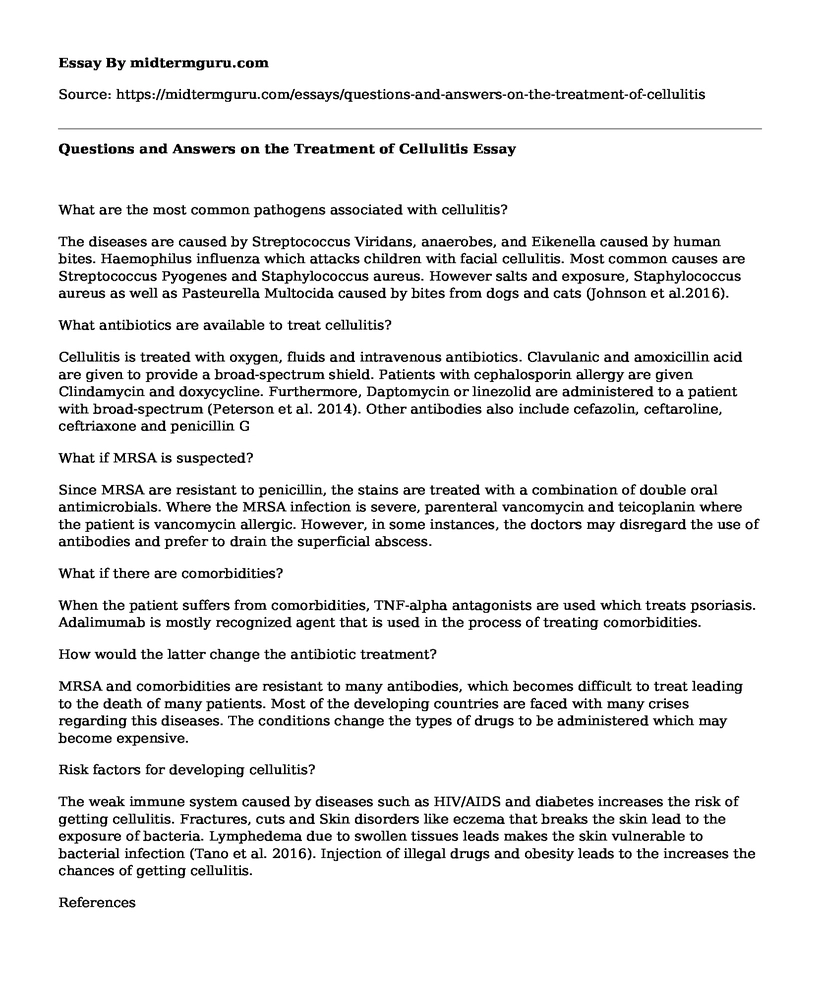What are the most common pathogens associated with cellulitis?
The diseases are caused by Streptococcus Viridans, anaerobes, and Eikenella caused by human bites. Haemophilus influenza which attacks children with facial cellulitis. Most common causes are Streptococcus Pyogenes and Staphylococcus aureus. However salts and exposure, Staphylococcus aureus as well as Pasteurella Multocida caused by bites from dogs and cats (Johnson et al.2016).
What antibiotics are available to treat cellulitis?
Cellulitis is treated with oxygen, fluids and intravenous antibiotics. Clavulanic and amoxicillin acid are given to provide a broad-spectrum shield. Patients with cephalosporin allergy are given Clindamycin and doxycycline. Furthermore, Daptomycin or linezolid are administered to a patient with broad-spectrum (Peterson et al. 2014). Other antibodies also include cefazolin, ceftaroline, ceftriaxone and penicillin G
What if MRSA is suspected?
Since MRSA are resistant to penicillin, the stains are treated with a combination of double oral antimicrobials. Where the MRSA infection is severe, parenteral vancomycin and teicoplanin where the patient is vancomycin allergic. However, in some instances, the doctors may disregard the use of antibodies and prefer to drain the superficial abscess.
What if there are comorbidities?
When the patient suffers from comorbidities, TNF-alpha antagonists are used which treats psoriasis. Adalimumab is mostly recognized agent that is used in the process of treating comorbidities.
How would the latter change the antibiotic treatment?
MRSA and comorbidities are resistant to many antibodies, which becomes difficult to treat leading to the death of many patients. Most of the developing countries are faced with many crises regarding this diseases. The conditions change the types of drugs to be administered which may become expensive.
Risk factors for developing cellulitis?
The weak immune system caused by diseases such as HIV/AIDS and diabetes increases the risk of getting cellulitis. Fractures, cuts and Skin disorders like eczema that breaks the skin lead to the exposure of bacteria. Lymphedema due to swollen tissues leads makes the skin vulnerable to bacterial infection (Tano et al. 2016). Injection of illegal drugs and obesity leads to the increases the chances of getting cellulitis.
References
Johnson, R. C., Ellis, M. W., Schlett, C. D., Millar, E. V., LaBreck, P. T., Mor, D., ... & Teneza-Mora, N. (2016). Bacterial Etiology and Risk Factors Associated with Cellulitis and Purulent Skin Abscesses in Military Trainees. PloS one, 11(10), e0165491.
Peterson, D., McLeod, S., Woolfrey, K., & McRae, A. (2014). Predictors of failure of empiric outpatient antibiotic therapy in emergency department patients with uncomplicated cellulitis. Academic Emergency Medicine, 21(5), 526-531.
Tano, S., Takeda, T., Uno, K., Yoshihara, M., Mayama, M., Ukai, M., ... & Oguchi, H. (2016). Risk factors for cellulitis in patients with secondary lower limb lymphedema associated with gynecological cancer treatment. European Journal of Obstetrics and Gynecology and Reproductive Biology, 206, e113-e114.
Cite this page
Questions and Answers on the Treatment of Cellulitis. (2021, Jun 08). Retrieved from https://midtermguru.com/essays/questions-and-answers-on-the-treatment-of-cellulitis
If you are the original author of this essay and no longer wish to have it published on the midtermguru.com website, please click below to request its removal:
- Distinct Characteristics of Nursing - Paper Example
- Benchmarking Healthcare Policy Analysis: Affordable Care Act
- Do Nurses Get Paid Enough? - Research Paper
- Humanitarian Assistance: Research Proposal
- ADHD and Autism - Essay Sample
- Drug Abuse & Overdose Death Rates Rise in US - Essay Sample
- Living a Healthy Lifestyle: A Necessity for a Healthy Life - Essay Sample







